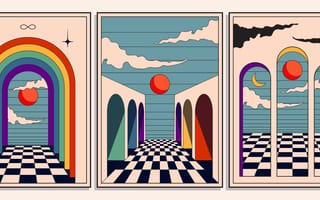Stellar design sprints start with structure. But the scaffolding of time constraints, phases and processes are intended to stoke something less tangible: serendipity.
“There’s a magic that happens when a diverse group of individuals collaborates, brainstorms and unleashes creativity,” said Peloton Senior Director of Global Product Design Ying Ying Hu.“In a design sprint, we create an opportunity for the team to bring their ideas to life — free from limitations — and get excited about the possibilities.”
Michelle Canning, EPAM Continuum Director of Experience Design, sees the sprint as a thrilling vehicle for melding the expertise of stakeholders with the design skills of the team, resulting in something unforgettable for both the business and its partners.
“There’s so much excitement that comes from the cross-functional ideation sessions,” she said. “By partnering with us as an outlet, we build on stakeholder ideas in a human-centered way.”
How can teams foster that sense of magic in their sprints? The answer lies in an equilibrium between structure and freedom.
As Riskified Marketing Design Team Lead Rob Marshbank said of the power of processes, “It’s all about the preparation: Measure twice, cut once.”
The solid structure of a design sprint is most effective when afforded the space for some ambiguity.
“It allows us to challenge assumptions, ask questions and identify the gaps of what we should really be solving for,” said Howl Senior Systems Designer Cody Cai.
Built In NY sat down with Cai, Marshbank, Canning and Hu to learn more about the steps they take in their respective design sprints to capture lighting in a bottle.
EPAM Systems, Inc is a global provider of software development, digital transformation and innovative solutions.
What does a design sprint look like at your company?
Our end-to-end approach is much more robust than a typical design sprint because we are committed to holistically understanding the problem and opportunities. As researchers, strategists and designers, our primary goal is to ensure our human-centered and data-driven approach includes enough time to truly understand the market, brand, business objectives and user needs. This allows us to create successful solutions and have a true impact on those who work with us.
At a high level, the stages are similar to a traditional five-day design sprint. Our robust, holistic approach to design sprints leads to true experience transformation for large-scale redesigns, space designs or when introducing something revolutionary to the market.
Our process begins by framing the problem and defining the key goals. All multidisciplinary team members who help generate new ideas are involved from the beginning — user experience, creative, content strategy, technology, analytics and so on.
Once we understand the current state and objectives, we learn as much as possible through deep-market and user research. We synthesize our research and align on a unified vision across the multi-disciplinary team. We test the solution with users to ensure the problem is being solved effectively.
What are some of the biggest mistakes people make while running design sprints and how can they be avoided?
Staying on track with the schedule during ideation sessions. It's easy to get off course when exciting new ideas are being generated — or when people are in the weeds on a feature or topic. The condensed timeline means rapid ideation and alignment to achieve results. A strong facilitator is needed to keep the team focused by moving the conversation along or redirecting if it’s becoming unproductive.
A strong facilitator keeps the team focused by moving the conversation along or redirecting when needed.”
Another challenge is maintaining focus with a large group of busy stakeholders. We ask everyone to close their laptops and put their phones away. We do our best to keep them on their feet and moving around. The more engaged they are in participating, the less inclined they will feel to turn to their devices. We also build in time to decompress, check email or meet any other obligations.
What is your favorite aspect of running a design sprint?
We’re generally meeting with stakeholders who have a wealth of knowledge — they’re immersed in this work every day. They have held onto ideas that we can make a reality. By partnering with us as an outlet, they can start imagining these ideas coming to life.
In these design sprints, I love receiving rapid feedback from users. Validating concepts and testing ideas is important to our process, ensuring what we are doing adds value and makes users’ lives easier. Design sprints allow for this to be achieved in a streamlined way over the course of a day.
Peloton is a global interactive fitness platform that aims to make fitness entertaining, approachable, effective, social and convenient.
What does a design sprint look like at your company?
Design sprints are an integral part of our product development process. We utilize a forward-looking product vision, aiming to ignite enthusiasm within our teams and help establish a clear North star.
These sprints truly come to life through their inclusive and collaborative nature — bringing together cross-functional teammates from product, design, content design, user research, engineering, analytics, marketing and various domain experts.
The heart of our design sprints lies in ensuring we are all on the same page with our goals and objectives. We place a strong emphasis on putting ourselves in the shoes of our users, valuing their needs and preferences throughout the process.
To fuel our brainstorming sessions, we utilize a jobs-to-be-done framework and ask ourselves how-might-we questions, which guide our creative thinking.
To fuel our brainstorming sessions, we utilize a jobs-to-be-done framework and ask ourselves how-might-we questions, which guide our creative thinking.”
To make well-informed decisions, we collect both qualitative and quantitative data before diving into the sprint. This data-driven approach empowers us to make more accurate and effective choices at every step of the way.
What are some of the biggest mistakes people make while running design sprints and how can they be avoided?
Lack of diverse participation. Ensure you have the right participants from cross-functional teams to bring in a wide range of perspectives and ideas.
Lack of buy-in. Get leadership and stakeholder buy-in by clearly communicating the purpose and expected outcomes of the design sprint.
Unclear goals. Define a clear goal for what you're aiming to solve during the sprint to keep everyone focused and on track.
Ignoring user insights. Incorporate user insights from the beginning to frame discussions and ensure solutions are user-centered.
No next steps. Plan for clear next steps after the sprint, outlining how the output will be utilized in upcoming roadmap planning.
Neglecting team dynamics. Foster a supportive and inclusive environment where all team members feel comfortable contributing their ideas.
What is your favorite aspect of running a design sprint?
Witnessing the magic that happens when a diverse group collaborates to solve a challenge that would typically exceed everyday bandwidth. It's truly inspiring to see people think outside the box and explore ideas that might have been constrained by technical limitations or the practicalities of minimum-viable-product thinking. It's incredibly rewarding to witness their enthusiasm and genuine belief in what they're creating.
Riskified strives to empower businesses to realize the full potential of e-commerce by making it safe, accessible and frictionless.
What does a design sprint look like at your company?
We work in two-week sprints and meet bi-weekly to plan for the following sprint. This framework allows us to estimate time needed, balance task distribution and deliver high-quality, creative solutions for each project.
We all assume project management-type roles for our respective tasks, enabling us to establish relationships and maintain regular communication channels with different teams. This way we can gain a comprehensive understanding of the goals, requirements and long-term visions of individual projects — as well as the long-term vision of Riskified as a company.
What are some of the biggest mistakes people make while running design sprints and how can they be avoided?
One thing we noticed early on was how important it is to have a clear understanding of each task. A major part of that understanding is to have all the information — where and how it will be used, reviewers, approvers, due dates and content like copy, size, and call to action — ready before beginning the sprint. Without that information, it is difficult to accurately estimate the time and effort needed for each project. Incorrect estimations can affect the delivery of all the other projects in the sprint.
What is your favorite aspect of running a design sprint?
Flexibility. By running design sprints the way we do, we create an environment where every team member gains an understanding of all Riskified’s current projects.
It also provides the flexibility for individuals to select projects that resonate with their interests and prevents individuals from being stuck with the same type of work. We’ve found this helps immensely with individual growth, building a well-rounded team and establishing a healthy work environment.
We provide the flexibility for individuals to select projects that resonate with their interests.”
Howl is a marketplace designed for creators and brands who crave transparent collaboration.
What does a design sprint look like at your company?
We work collaboratively on design sprints in what we call “pods,” which consist of our design team, an engineering lead, product manager and at least one stakeholder from leadership. Although the sprint itself is more focused naturally on design, it’s great to get deep and diverse perspectives from the start to help drive and inform the problem we are solving.
Our team uses design sprints when we want to work through a loosely defined epic or problem statement. Of course, it’s preferred and expected to have objectives, key results and deliverables identified.
What are some of the biggest mistakes people make while running design sprints and how can they be avoided?
Subjectivity. Participants are often too close to their own point-of-view of the problem, hindering their ability to redefine and reinvent from a strategic and design standpoint. When approaching the design sprint, it's best to think objectively and eliminate bias. It’s important early on in the sprint for the team to have a candid conversation about their assumptions and encourage self-reflection about bias.
Another common mistake is rushing the design sprint. Though it’s called a sprint, it’s essential to be intentional about the process and take the time to reflect as a team.
Though it’s called a sprint, it’s essential to be intentional about the process and take the time to reflect as a team.”
Try to find time every day to reconvene as a team. Reevaluate and adapt to make sure each individual is spending their time being most impactful and that the problem is still the one you should be solving for.
What is your favorite aspect of running a design sprint?
When the team has discovered its purpose and has shaped the sprint into an actionable deliverable. There is that “ah-ha” moment that often comes when turning the idea into a testable hypothesis — when the outcome reaches that next level of inventiveness that makes me want to run another design sprint.













